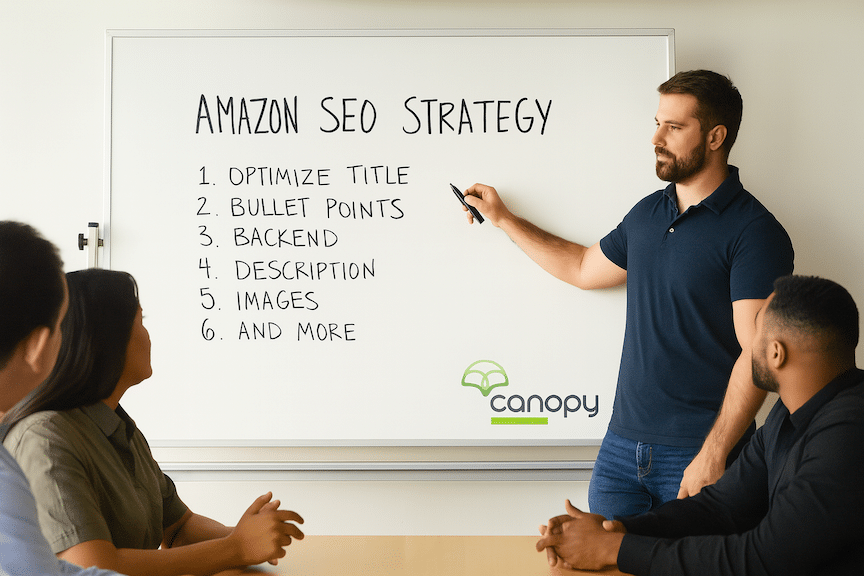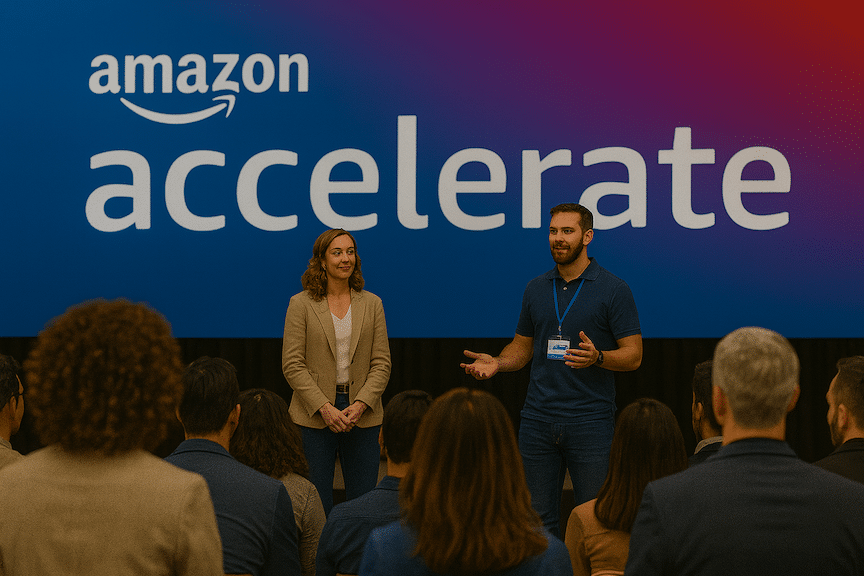How to Do Amazon SEO: 5 Proven Strategies That Work Right Now!
Master Amazon’s A9 algorithm with proven SEO strategies. Get higher rankings, more organic sales, and reduced PPC costs in 2025

Amazon isn’t Google with a shopping cart attached.
It’s a conversion-optimized sales machine disguised as a search engine.
The marketplace reality: 80% of Amazon purchases happen from page one of search results, yet most sellers are still using outdated keyword stuffing tactics from 2015.
Canopy Management’s ecommerce strategists have analyzed 3.32 billion in performance data across our entire partner network and have discovered a fundamental disconnect between what sellers think Amazon rewards versus what actually drives rankings.
Here’s what the data reveals:
- Benefit-driven titles consistently outperform keyword-stuffed alternatives
- External traffic generation has become essential for top rankings (not optional)
- Conversion-focused optimization delivers double-digit improvements versus keyword-only approaches
The sellers winning in 2025 aren’t just optimizing listings. They’re building systematic SEO processes that align with Amazon’s core objective: maximizing revenue per customer search.
The Amazon vs. Google Algorithm Reality
Google’s Mission: Provide the most relevant answer to any query
Amazon’s Mission: Convert searches into profitable sales as efficiently as possible
This fundamental difference reshapes everything about optimization strategy.
How Search Intent Differs
Google Users:
- 49% start product research on Google for discovery
- Mix of informational, navigational, and commercial queries
- Longer consideration periods
Amazon Users:
- 59% start on Amazon when they know what to buy
- High commercial intent from first click
- Ready to purchase now
Algorithm Priorities: The Critical Differences
| Factor | Google SEO | Amazon A9 |
| Primary Signal | Backlinks & E-E-A-T | Conversion Rate & Sales Velocity |
| Content Focus | Long-form, educational | Concise, benefit-driven |
| User Behavior | Time on page, engagement | Click-through → conversion |
| External Links | Essential ranking factor | No direct ranking impact |
| Performance Metrics | Bounce rate, session duration | Unit session percentage, repeat purchases |
Bottom Line: Amazon rewards listings that convert browsers into buyers. Everything else is secondary.
Ready to Start Growing Your Amazon Brand?
Canopy’s Partners Achieve an Average 84% Profit Increase!
Find out moreThe 5-Pillar Amazon SEO Framework
Pillar 1: Strategic Keyword Research & Semantic Mapping
Move beyond basic keyword lists to understand customer search psychology.
Data Sources (In Priority Order):
- Amazon’s Search Bar Autocomplete – Real customer queries happening now
- PPC Search Term Reports – Your proven converting keywords
- Amazon Brand Analytics – Official Amazon search volume data (Brand Registry required)
- Competitor Reverse ASIN Analysis – Keywords driving competitor sales
The Semantic Expansion Strategy:
Instead of targeting just “wireless headphones,” map the complete customer journey:
- Problem-focused: “headphones that don’t fall out”
- Use-case specific: “workout headphones wireless”
- Feature-driven: “noise canceling bluetooth earbuds”
- Demographic: “small ear wireless headphones women”
Keyword Allocation Framework:
- Tier 1 (Title): Primary keyword + brand + main benefit
- Tier 2 (Bullets): Secondary keywords + features + use cases
- Tier 3 (Backend): Long-tail + synonyms + misspellings + regional variations
Pillar 2: Conversion-Optimized Listing Architecture
Product Title Optimization (2025 Guidelines)
Updated Requirements:
- 200-character maximum (125 for select apparel categories)
- No more than 2 repetitions of any word (including variations)
- Mobile-first approach: critical info in first 80 characters
Winning Title Formula: [Brand] + [Primary Keyword] + [Key Benefit] + [Important Feature/Use Case]
Example Transformation:
❌ Old approach: “Wireless Headphones Bluetooth Earbuds Wireless Bluetooth Headphones for Running Gym Workout Sports”
✅ New approach: “SoundPro Wireless Earbuds – 24Hr Battery Life with Secure Sports Fit for Running & Gym Workouts”
Bullet Points That Drive Conversions
Lead with customer outcomes, not technical specifications.
Framework: Benefit + Feature + Proof
❌ Feature-focused: “Made with 304 stainless steel construction”
✅ Benefit-driven: “BUILT TO LAST A LIFETIME – Premium 304 stainless steel resists rust and daily wear, backed by our 10-year replacement guarantee”
Use all 5 bullet points to address:
- Primary benefit/main problem solved
- Key differentiator vs. competitors
- Quality/durability assurance
- Use case versatility
- Purchase confidence (warranty, guarantee, etc.)
Backend Search Terms Strategy
250-byte optimization rules:
- Include synonyms NOT in front-end copy
- Add common misspellings customers actually use
- Regional spelling variations (colour/color, grey/gray)
- Relevant foreign language terms for diverse markets
Never include: Repeated front-end keywords, competitor brands, promotional terms, punctuation
Pillar 3: Visual Conversion System
High-quality imagery drives 70%+ of purchase decisions on Amazon.
Strategic 7-Image Sequence:
- Hero Shot: Clean product on white background, 85% frame fill
- Lifestyle Context: Product being used in aspirational setting
- Benefit Infographic: 3-5 key advantages with clear visual callouts
- Scale Reference: Size context with familiar objects or dimensions
- Quality Close-up: Materials, craftsmanship, premium details
- Packaging Experience: Professional unboxing presentation
- Product Video: 15-45 second demonstration (essential for top rankings)
Technical Specifications:
- Minimum 1000px on longest side (enables zoom)
- Main image: Pure white background (RGB 255,255,255)
- Mobile optimization critical (80% of traffic)
Pillar 4: External Traffic Amplification
Major Algorithm Shift: The A9 algorithm heavily rewards listings that attract qualified traffic from off-Amazon sources.
Multi-Channel Traffic Strategy:
Social Commerce Integration:
- TikTok product demonstrations and unboxing content
- Instagram Story links with clear product benefits
- YouTube product reviews and tutorials
Search Engine Marketing:
- Google Ads campaigns linking directly to Amazon listings
- SEO-optimized blog content driving traffic to products
- Pinterest product pins for visual categories
Email & Community Marketing:
- Product launch announcements to existing customers
- Educational newsletter content with product integration
- Influencer partnerships with authentic product placement
Amazon Attribution Setup Process:
- Access through Brand Registry advertising console
- Create campaign-specific tracking URLs
- Implement across all external marketing channels
- Monitor 14-day attribution window for conversions
- Optimize budget allocation based on performance data
Pillar 5: Performance Optimization Loop
Core KPI Dashboard:
- Keyword Rankings: Top 20 target terms position tracking
- Conversion Rate: Unit Session Percentage trends
- Traffic Quality: Organic vs. paid ratio improvement
- External Impact: Attribution-tracked sales volume
Continuous Improvement Process:
Monthly Optimization Cycle:
- Audit Performance: Compare metrics vs. top 3 competitors
- Identify Gaps: Ranking, conversion, or traffic opportunities
- Form Hypothesis: Data-driven improvement theory
- A/B Test: Use Amazon’s “Manage Your Experiments” tool
- Implement Winners: Scale successful variations
- Document Results: Build optimization playbook
Advanced Implementation Tactics
The Amazon Ranking Flywheel
First Phase: Foundation (Days 1-30)
- Launch with strategic PPC for initial velocity
- Drive external traffic burst for algorithm signals
- Generate early reviews through compliant methods
Second Phase: Acceleration (Days 31-90)
- Optimize based on real customer search terms
- Scale winning external traffic sources
- Refine listing elements using conversion data
Third Phase: Dominance (Days 91+)
- Reduce PPC dependency as organic rankings strengthen
- Expand keyword footprint to related terms
- Build brand authority through content marketing
Category-Specific Optimization Approaches
High-Competition Categories (Electronics, Home & Kitchen):
- Focus on long-tail, specific use-case keywords
- Emphasize unique product differentiators
- Invest heavily in external traffic generation
Emerging Categories (Health Tech, Smart Home):
- Target broader keywords while competition is lower
- Build educational content to establish authority
- Capture early market share through aggressive optimization
Seasonal Products:
- Build year-round traffic through educational content
- Develop email lists during off-seasons
- Create content hubs that drive consistent traffic
Ready to Start Growing Your Amazon Brand?
Canopy’s Partners Achieve an Average 84% Profit Increase!
Find out morePerformance Tracking & Optimization
Essential Tool Stack
Keyword Intelligence:
- Helium 10: Comprehensive keyword research and rank tracking
- Jungle Scout: Competitor analysis and market opportunity identification
- Amazon Brand Analytics: Official search volume and market share data
Performance Monitoring:
- Amazon Attribution: External traffic conversion tracking
- Seller Central Analytics: Conversion and session data
- Third-party rank trackers: Historical keyword position trends
Success Metrics Timeline
Week 1-2: Initial keyword indexing and PPC performance
Month 1: Conversion rate optimization and image testing results
Months 2-3: Organic ranking improvements for target keywords
Month 4-6: External traffic impact and reduced PPC dependency
Month 6+: Market share growth and brand authority signals
Critical Mistakes That Tank Rankings
The Fatal Five SEO Errors
1. Keyword Stuffing (2025 Algorithm Penalty) The A9 algorithm actively penalizes unnatural keyword repetition. Write for humans first, optimize for search second.
2. Mobile Neglect 80% of Amazon shoppers browse on mobile. Front-load critical information and use scannable formatting.
3. Inventory Stockouts Going out of stock destroys sales velocity momentum. Recovery can take 3-6 months. Invest in demand forecasting.
4. Review Strategy Violations Fake reviews or review manipulation can result in permanent account suspension. Use only compliant review generation methods.
5. Technical Policy Violations Account health issues directly impact rankings. Monitor Account Health dashboard daily and address issues immediately.
Performance Recovery Strategies
Ranking Drop Recovery:
- Audit for policy violations or account health issues
- Analyze competitor movements and algorithm changes
- Increase external traffic and PPC investment temporarily
- Optimize conversion rate through listing improvements
- Monitor recovery progress weekly
Amazon SEO Implementation FAQ
Q: How long does Amazon SEO take to show results?
A: Initial keyword indexing happens within 24-48 hours. Meaningful ranking improvements typically appear within 30-60 days with consistent optimization.
Q: What’s the most important ranking factor for Amazon?
A: Conversion rate (Unit Session Percentage) is the strongest ranking signal. A listing that converts browsers into buyers will outrank higher-traffic listings with poor conversion.
Q: Should I focus on Amazon SEO or PPC first?
A: Use PPC to generate initial data and sales velocity, then optimize organically based on proven converting keywords. The goal is reducing PPC dependency over time.
Q: How often should I update my listing optimization?
A: Test major changes monthly using Amazon’s A/B testing tools. Make data-driven adjustments based on performance trends rather than frequent random changes.
Q: Is external traffic really necessary for Amazon SEO success?
A: Yes. The A9 algorithm significantly rewards listings that attract qualified traffic from off-Amazon sources. It’s no longer optional for competitive categories.
Bottom Line: Systems Beat Tactics
Amazon SEO success in 2025 requires systematic thinking, not quick fixes.
The brands dominating Amazon aren’t just optimizing listings – they’re building comprehensive systems that create genuine customer value while satisfying algorithm requirements.
The winning approach combines:
- Customer-focused keyword strategy based on real search behavior
- Conversion-optimized listing architecture that drives purchases
- Multi-channel traffic generation that signals broader market demand
- Data-driven optimization processes that compound results over time
At Canopy Management, our systematic approach to Amazon SEO has helped partners achieve an average 84% year-over-year profit increase.
Most sellers are still fighting yesterday’s algorithm. The opportunity for systematic sellers has never been greater.
Ready to implement systematic Amazon SEO for your brand?
Our proven framework has generated over $3.32 billion in revenue for partners, with 99.1% retention rate year-over-year.
Canopy Management is a full-service marketing agency for Amazon, Walmart, and TikTok sellers. Our team consists of multi-million dollar, omni-channel entrepreneurs, industry leaders, and award-winning experts.
Ready to Start Growing Your Amazon Brand?
Canopy’s Partners Achieve an Average 84% Profit Increase!
Find out more

